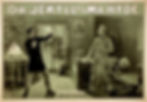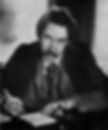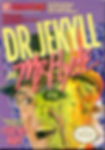Dr Jekyll and Mr Hyde: From Fantasy Horror Book to Multi-Media Sensation
- eframss
- Dec 17, 2023
- 6 min read
In 1886 the famed Scottish writer Robert Louis Stevenson published the gothic novella, Strange Case of Dr Jekyll and Mr Hyde. Since its release, an industry devoted to the story has blossomed. Theatrical performances, feature films, cartoons, graphical novels, and even video games, are just some of the ways Stevenson’s story has been adapted for audiences.

CAPTION: Advertisement Poster from the 1880s.
In this instalment of the Historical Ghostbuster blog, I want to explore the history of Dr Jekyll and Mr Hyde, along with some of its early adaptations from the first half of the twentieth century, especially Richard Mansfield’s four-act play from 1887. Enjoy!

CAPTION: Title Page of Robert Louis Stevenson’s Strange Case of Dr Jekyll and Mr Hyde
Prior to writing Dr Jekyll and Mr Hyde, Stevenson had long been interested in conceptions of duality, and how a person can possess two very different personas.

CAPTION: Portrait of Robert Louis Stevenson, 1885
Scholars have discussed all manner of influences to have shaped Stevenson’s writings, but his early fascination with the eighteenth-century cabinet maker and burglar William Brodie is one of the more interesting inspirations behind the development of Dr Jekyll and Mr Hyde.
During the late 1780s, Brodie was an accomplished cabinet maker and locksmith in Edinburgh, Scotland. His clients were mainly drawn from the upper echelon of the city’s wealthiest class.
Brodie was so well established in his trade, that he even earned the title of “Deacon” of cabinet makers in Edinburgh, which roughly is equivalent to “president” of his guild.
Brodie was particularly skilled in making, and also fixing, security mechanisms. He would often be invited into his clients’ households to manage and maintain their security, including cabinets to store valuables.
This provided the perfect opportunity (and cover) for Brodie to scope the location and gain valuable insights about the property's layout. You see, by night, Brodie was a burglar and robbed the very households he serviced with the help of his gang.
While visiting properties, Brodie often made wax impressions of locks so that he could make duplicate keys back at his workshop.

CAPTION: Portraits of Scottish Cabinet Maker William Brodie from the 1788
Brodie was eventually arrested in 1788 after the failed burglary of a customs house. During the burglary, Brodie and his gang were unexpectedly interrupted by a customs officer. At the time, the group believed that the building was empty.
Brodie managed to escape and make it back to his house. He quickly changed clothes and visited his mistress to create an alibi.
Unfortunately, two of Brodie’s accomplices were sold out by a third member of the gang. That member was offered a pardon if he snitched on his fellow gang members. He also revealed the location of a secret stash of duplicate keys.
The other members of the gang were arrested, and Brodie tried to visit them in jail. However, he was denied entry. Realising he was almost certainly next to be arrested, Brodie went on the run but was eventually caught Amsterdam. He was trying to gain passage to the USA.
At the trial it was the testimonies of two of his accomplices that led to his conviction. He was hanged in October 1788 before a crowd of 40,000 people. Needless to say, people sought differerent forms of entertainment in those days...
The story of Brodie was famous in Edinburgh, and Stevenson found the case to be rather intriguing. How was it possible for such an esteemed artisan like Brodie to be also a high-level burglar? Those activities seemed completely opposite. It was this double life, which so fascinated Stevenson, that partially inspired elements of the Jekyll and Hyde character in his book.
After the publication of Dr Jekyll and Mr Hyde in 1886 it was not long before adaptions of the story emerged.

CAPTION: Playbill for August 1888 production of Dr. Jekyll and Mr. Hyde at the Lyceum Theatre in London
The first notable adaption was a four-act theatrical performance that initially ran in Boston Massachusetts in May of 1887. The script was written by Thomas Russell Sullivan and starred the early American stage actor Richard Mansfield.
Sullivan made several changes to the original storyline, most notably the addition of Jekyll’s fiancée, Agnes Carew.
The original production premiered on 9 May 1887 at the Boston Museum (which later merged with the Museum of Fine Arts, Boston). However, after only five days, the production ended and Sullivan set to work on rescripting the play.
The updated version relaunched on 12 September 1887 at Madison Square Theatre on Broadway, NY. It was a huge success, and by October of that year the production went on tour, with performances in over a dozen American cities. The tour ended in June 1888 back in New York City.
To promote the show, Mansfield had a specially made composite photograph of himself portraying both sides of the titular character. In the image, one can see the actor standing up and in a thoughtful pose as Jekyll, and bending over with an almost monstrous stance as Hyde.
At the time of its creation, composite photography was a relatively new special effect for the visual medium. Thus, it was a real eye catcher for would-be ticket buyers.

CAPTION: Composite portrait of the actor Richard Mansfield portraying both Dr Jekyll and Mr Hyde. Used for promotional material, c. 1887
The success of the Mansfield production attracted a lot of attention, and it wasn’t long before the show went over to London.
The English actor Henry Irving attended one of Mansfield's shows in New York and was wowed by the performance. At the time, Irving was managing the Lyceum Theatre in London and convinced Mansfield to bring his play to England.

CAPTION: Woodcut advertisement of Dr Jekyll and Mr Hyde from the Penny Illustrated News, 1888
The English production opened on 4 August 1888, and throughout the season
Mansfield fought regularly with Irving and his team. These arguments were mainly about the artistic vision of the show.
Mansfield also faced other problems. Several unauthorized productions of the play sprung up in different parts of London. Stevenson’s publisher Longmans, Green and Co. tried to help Mansfield in taking legal action against these unauthorized competitors. However, they were difficult to stop.
The biggest thing to impact the success of Mansfield’s play in London were the Jack the Ripper murders, which began on the 7th of August in 1888. This was only three days after Mansfield’s show opened in London.

CAPTION: Illustration depicting the discovery of Mary Ann Nichols, first canonical victim of the Ripper. From the 8 September 1888 edition of the Penny Illustrated Paper.
As the Ripper case unfolded in the press, paranoia set in. Due to the dark nature of Stevenson’s story, and Mansfield’s incredible performances as the violent and sadistic Hyde, he became an early suspect in the Ripper case. Some observers argued that Mansfield was uncomfortably good at portraying two vastly different personas and therefore could easily disguise himself if he were the real Ripper killer.
While both the alleged links to the Ripper murders and the legal cases against unauthorized productions of Mansfield’s play generated significant buzz in the press, low ticket sales were ultimately responsible for the show’s short stay in London.
Mansfield was losing money on the production and decided not to renew his tenancy at the Lyceum. When his lease ended in December 1888 the production ended.
Theatrical performances of Stevenson’s Dr Jekyll and Mr Hyde continued throughout the closing decades of the nineteenth century.
However, it was not until 1912 that the first cinematic adaptation of the book was released. It was directed by Lucius J. Henderson, an accomplished early American director, who produced over 70 silent films.
Unlike Mansfield’s production, two actors shared the roles of the titular character. James Cruze played the part of Jekyll and Harry Benham was Hyde.
The storyline was closer to the theatrical production from 1887, which Henderson argued was easier to adapt into a short 12-min film compared to that Stevenson’s book.
The release of the film in 1912 marked the beginning of a wave of cinematic adaptions during the early decades of the twentieth century.
So, there you have it. Stevenson’s Dr Jekyll and Mr Hyde is a Victorian masterpiece, and wonderful example of early fantasy writing. One might go so far as to call it fantasy horror, or even popular occulture.
It was already inspiring people to adapt its storyline to other media within a year of its original release. Mansfield’s four-act play from 1887 was one of the first high-profile adaptations to reach a broad audience. But it wouldn’t be the last.
By the opening decades of the twentieth century there were all sorts of other adaptions emerging, especially in the budding film industry. Today the dual character of Jekyll and Hyde is one of the most recognisable figures from fantasy fiction.
In fact, by the late 1980s, Jekyll and Hyde even became the basis of a Nintendo videogame. Thus, within a century, Stevenson’s story developed from print to stage, and from stage to film and videogames. That’s a truly impressive evolution!

CAPTION: Box art for the Dr Jekyll and Mr Hyde videogame produced by Bandai, 1988
REFERENCES
Justin A. Blum, “The Lyceum Theatre and its Double: Richard Mansfield's Visit to the Greenwich Meridian of Late-Victorian Theatre,” Nineteenth Century Theatre and Film, 41 (2014), 102–121
L. Perry Curtis, Jr., Jack the Ripper and the London Press, (New Haven: Yale University Press, 2001)
David Hutchinson, Deacon Brodie: A Double Life, (CreateSpace Independent Publishing, 2015)
Scott Allen Nollen, Robert Louis Stevenson: Life, Literature and the Silver Screen, (Jefferson: McFarland, 1994)
Robert Louis Stevenson, Strange Case of Dr Jekyll and Mr Hyde, (London: Longmans, Green and Co., 1886)